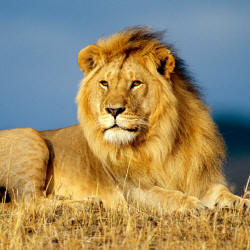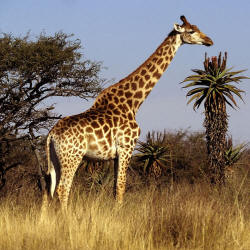World Animals
African Animals
Lion

Animal Kingdom: Big Cat, Mammal
Population: 30.000 - 100.000
Size: H: 0.8 m - 1.1 m, L: 1.4 m - 2 m
Weight: 120 kg - 190 kg
Life Expectancy: Max. 30 years
Food source: Gazells, Zebras and other sources of meat
Max. speed: 75 km/h
Nutritional value: Rich in protein and iron
The lion (Panthera leo) is one of the four big cats in the genus
Panthera and a member of the family Felidae. With some males exceeding
250 kg (550 lb) in weight, it is the second-largest living cat after the
tiger. Wild lions currently exist in sub-Saharan Africa and in Asia
(where an endangered remnant population resides in Gir Forest National
Park in India) while other types of lions have disappeared from North
Africa and Southwest Asia in historic times. Until the late Pleistocene,
about 10,000 years ago, the lion was the most widespread large land
mammal after humans. They were found in most of Africa, across Eurasia
from western Europe to India, and in the Americas from the Yukon to
Peru. The lion is a vulnerable species, having seen a major population
decline in its African range of 30–50% per two decades during the second
half of the 20th century. Lion populations are untenable outside
designated reserves and national parks. Although the cause of the
decline is not fully understood, habitat loss and conflicts with humans
are currently the greatest causes of concern. Within Africa, the West
African lion population is particularly endangered.
Lions live for 10–14 years in the wild, while in captivity they can live
longer than 20 years. In the wild, males seldom live longer than 10
years, as injuries sustained from continual fighting with rival males
greatly reduce their longevity. They typically inhabit savanna and
grassland, although they may take to bush and forest. Lions are
unusually social compared to other cats. A pride of lions consists of
related females and offspring and a small number of adult males. Groups
of female lions typically hunt together, preying mostly on large
ungulates. Lions are apex and keystone predators, although they scavenge
as opportunity allows. While lions do not typically hunt humans, some
have been known to do so. Sleeping mainly during the day, lions are
primarily nocturnal, although bordering on crepuscular in nature.
Giraffe

Animal Kingdom: Long throated camel, Mammal
Population: 110.000 - 150.000
Size: H: app. 5.5 m, L: app. 3.2 m
Weight: app. 1.2 tonnes
Life Expectancy: max. 34 years
Food source: High grown leaves
Max. speed: 51 km/h
Nutritional value: Tonnes of calcium and carbon
The giraffe (Giraffa camelopardalis) is an African even-toed ungulate
mammal, the tallest living terrestrial animal and the largest ruminant.
Its species name refers to its camel-like appearance and the patches of
color on its fur. Its chief distinguishing characteristics are its
extremely long neck and legs, its horn-like ossicones and its
distinctive coat patterns. It stands 5–6 m (16–20 ft) tall and has an
average weight of 1,600 kg (3,500 lb) for males and 830 kg (1,830 lb)
for females. It is classified under the family Giraffidae, along with
its closest extant relative, the okapi. The nine subspecies are
distinguished by their coat patterns.
The giraffe's scattered range extends from Chad in the north to South
Africa in the south, and from Niger in the west to Somalia in the east.
Giraffes usually inhabit savannas, grasslands, and open woodlands. Their
primary food source is acacia leaves, which they browse at heights most
other herbivores cannot reach. Giraffes are preyed on by lions, and
calves are also targeted by leopards, spotted hyenas and wild dogs.
Adult giraffes do not have strong social bonds, though they do gather in
loose aggregations if they happen to be moving in the same general
direction. Males establish social hierarchies through "necking", which
are combat bouts where the neck is used as a weapon. Dominant males gain
mating access to females, which bear the sole responsibility for raising
the young.
The giraffe has intrigued various cultures, both ancient and modern, for
its peculiar appearance, and has often been featured in paintings, books
and cartoons. It is classified by the International Union for
Conservation of Nature as Least Concern, but has been extirpated from
many parts of its former range, and some subspecies are classified as
Endangered. Nevertheless, giraffes are still found in numerous national
parks and game reserves.